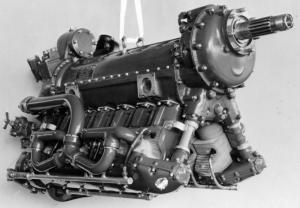
The Ranger SGV-770
The (Fairchild) Ranger SGV-770
Compiled by Kimble D. McCutcheon
from Documents Provided by Michael Smith
Published 1 Jul 2018
 The Ranger SGV-770 |
The Ranger SGV-770 C-1 is an air-cooled, in-line, inverted engine. It therefore combines the light weight of the air-cooled engine; the small frontal area of an in-line engine and the good forward visibility made possible by the inverted position. |
Pressure Cooling
In combining the various advantages of an invertied V-12, certain technical difficulties had to be solved, the most serious one of which was the cooling problem. Since only the front cylinders were exposed to a direct air blast, some method had to be found to provide equal cooling for all cylinders. This has been accomplished means of pressure cooling.
The principle of pressure cooling is to provide an air chamber adjacent to the cylinders, with its open end facing forward. The forward velocity of the airplane, as well as the fan action of the propeller, will build up air pressure in this chamber. Since they pressure on one side of the cylinders is higher than that on the other side, air will tend to escape between the cylinders. Specially designed baffles close the gap between the cylinders and force the air to flow around the cylinders, between the cooling fins, thus assuring a maximum cooling effect. On this particular engine the pressure chamber is formed by an air scoop, so-called because it literally scoops up the cooling air. The air scoop bottom is formed by a piece of sheet metal that fits tightly against the camshaft housing bottoms. The scoop sides are formed by the cylinders, and an end baffle across the scoop rear completes the pressure box. The amount of cooling air flowing over the cylinders is governed by the difference between the high scoop air pressure and the much lower pressure within the rest of the engine cowling. Scoop pressure depends almost entirely on the airplane's forward speed. At slow speeds the pressure is low and at high speeds there is considerable pressure. Pressure on the other side of the cylinder can be varied on most installations by the use of cowl flaps. These flaps vary the size and shape of the opening by which the cooling air escapes. In the full open position they are designed to create a suction that draws the hot air out of the cowling. This is necessary when the air scoop pressure is low because the plane is standing still or moving slowly. At high forward speeds this suction is unnecessary because there is enough scoop pressure to force the air through the fins and the cowl flaps can therefore be closed. The entire. system can only operate effectively if the air stoop and cylinder baffles fit tightly, so that the only path for the airflow is through the cylinder fins. Any leaks such as would be caused by loose baffles or by a poor fit between air scoop and engine will lower the effective air pressure. This may cause overheating in the vicinity of the leak and may result in eventual damage to the engine.
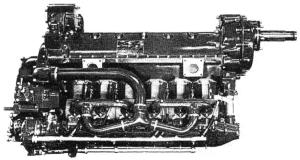 |
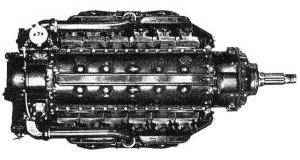 |
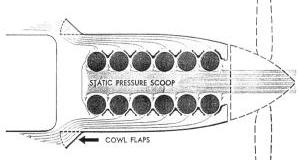 |
| Right | Top | Cooling Air Flow |
Construction
The Ranger SGV-770 C-1 is a 60° V-12 air-cooled inverted engine of 772.8 in³ displacement. It is supercharged and drives the propeller through a 3:2 reduction gear.
The aluminum alloy crankcase is split into an upper and lower half at the crankshaft centerline. Both crankcase halves have seven webs that support the main bearings. Fourteen main bearing bolts, anchored in the lower crankcase webs and extending through the upper crankcase, clamp the main bearing saddles. The crankcase flanges are sealed with rubber strips and held together by closely spaced studs. The crankcase lower half of the main crankcase carries four mounting pads, each with four studs, which secure feet that mount the engine to the airplane.
The crankcase front section is of cast aluminum alloy and carries gears that drive the accessory drive shaft, camshafts and propeller governor. It also acts as the reduction gear housing.
The reduction gears are of the herringbone type. The large driven gear lies directly above the smaller driving gear, which raises the propeller shaft center line inches above the crankshaft center. This provides better visibility for the pilot and more efficient engine cooling by moving the air scoop opening further away from the propeller center. The driving gear is connected to the crankshaft end by a short, hollow quill shaft. The driven gear is bolted directly to the propeller shaft, which is supported on two roller bearings. A roller thrust bearing transmits the propeller thrust load. The hollow propeller shaft has a standard S.A.E. 50 spline. Provision has been made for the installation of either a constant speed or two-position hydraulically operated propeller.
The crankcase rear section is of cast magnesium alloy and provides accessory mounting pads and drives. It is removable as a unit and forms the forward supercharger housing half.
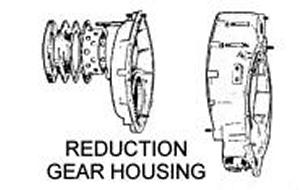 |
 |
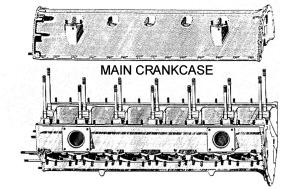 |
 |
| Crankcase Front Section | Reduction Gearing | Crankcase Main Section | Crankcase Rear Section |
The six-throw crankshaft is a steel forging machined all over. It runs in seven main bearings and is statically and dynamically balanced. The shaft front end carries a spline that engages the quill shaft. The shaft aft end carries a gear that engages with the starter and generator drive through an idler gear in the rear section. All other drives are taken off the shaft front end. The crankpins and main journals are drilled for lightness and to-act as oil reservoirs. Crankpins are fitted with cast aluminum plugs with cast-in chambers that act as centrifugal sludge filters. The main journals are fitted with two-piece aluminum plugs that are bolted together. All crank cheeks have oil passages drilled in them so that each crankpin receives its oil supply from two separate passages. The crankshaft is equipped with four dynamic vibration absorbers located at the first, third, forth and sixth crank throws. These are floating counterweights supported on needle bearings and are designed to absorb crankshaft torsional vibration. They differ from bifilar vibration absorbers typically of radial engines in that they employ a kidney-shaped track upon which a roller bearing runs, allowing the mass to swing at a frequency proportional to crankshaft rotational rate.
 |
 |
| Crankshaft Assembly | Tuned Vibration Absorber |
Connecting rods having an I-section are machined from alloy steel forgings. Right-hand rods are of the fork type while left-had ones are of the blade type. A steel-backed copper-lead bearing is clamped in the fork rod big end. The blade rod bears on a bronze ring around the bearing shell outer diameter. Bronze bushings are used in the connecting rod small ends.
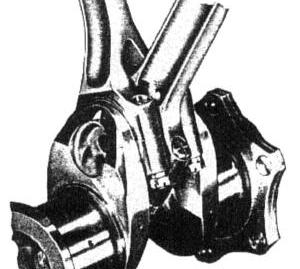 |
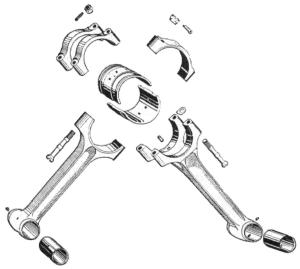 |
| Fork-and-Blade Connecting Rods Assembled | Fork-and-Blade Connecting Rods Exploded |
Pistons of forged aluminum alloy are of the full trunk type. Four piston rings of 1/16" width are used, Three compression rings are located between piston pin boss and piston head and a beveled oil scraper ring is at the lower end of the skirt. Heat treated alloy steel piston pins arc fully floating and are retained by spring steel circlip in the piston pin bore.
Cylinder heads of an aluminum alloy are cast with closely spaced fins. One aluminum bronze intake valve seat and one Stellite steel exhaust valve seat are shrunk into the cylinder head. The intake valve seat has a rounded profile that makes line contact with the 30° intake valve face and is designed to streamline the intake passage. The exhaust seat is of the standard 30° type. Two bronze valve guides are also shrunk into the cylinder head. Spark plug holes are fitted with Aero Thread spiral inserts.
Cylinder barrels are machined from chrome molybdenum forgings and are screwed and shrunk into the cylinder head. A heavy steel flange is machined at the base of each cylinder barrel. This is used to secure the cylinder to the crankcase, using eight hold-down stud. A rubber ring around the cylinder skirt prevents oil leakage at the: cylinder pad.
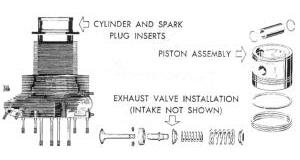 |
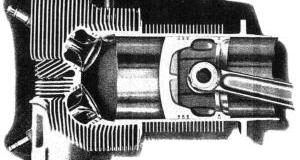 |
| Cylinder Components | Cylinder Cutaway |
Forged steel camshafts are carried in magnesium alloy housings that bolt directly onto the cylinder heads. The camshafts are each supported in seven bearings and driven through bevel gears from a drive shaft at the front ends. The bronze front bearing, adjacent to the bevel gear, also absorbs thrust loads imposed by the bevel gear. The other six bearings are located just aft of a pair of cams and have no bushings. Valves are operated by steel rocker arms equipped with needle bearings. Cam followers are of the roller type. Valve clearances are adjusted by screws in the rocker arms. The adjusting screw ends carry a steel ball in a socket, which provides a large contact area with the valve stem and eliminates the need for adjustments between overhaul. The tulip-type valves are of forged alloy steel and the exhaust valve is sodium cooled. Both valve have two springs.
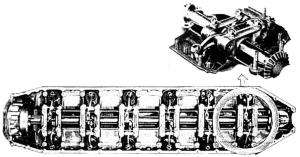 |
| Valve Gear, Viewed from Below, with Detail |
Engine lubrication is of the full pressure type with a dry crankcase and external oil tank. A gear type pump on the rear crankcase right side forces oil through a lamainar filter and pressure relief valve. The main oil filter is equipped with a spring-loaded bypass that opens automatically if the filter becomes clogged. Part of the main oil supply is fed to the rear accessory drive gears through a system of cast-in passages. Most of the oil enters the accessory drive shaft that drive front-end accessories. This shaft lies at the lowest point of the main crankcase, between the cylinders, and acts as the main oil gallery. It supplies all main bearings through vertical passages cast into the crankcase webs. From the main bearings the oil passes into the crankpins through crank cheek passages. Cylinder walls, pistons, and piston pins are lubricated by oil thrown off the crankpins. Pressure oil is supplied from the accessory drive shaft front to various front-section accessory drive gears and the reduction gears. Pressure oil also travels through the hollow vertical shafts to camshafts and camshaft bearings. Small holes drilled between each pair of cams also provide an oil spray for the valve mechanism.
Scavenge oil collects in the crankcase bottom and is prevented from running into the cylinders by cylinder skirts that project well above the crankcase bottom. This oil drains through two front drive shaft housings and through two rear drain tubes. A double scavenge oil pump is drive off the rear end of each camshaft. These pumps have two suction inlets, one connected to the front and one to the rear of each cam housing, so that scavenging is complete for both nose-up and nose-down attitudes. Both pumps return oil to the oil tank through a common tube by way of an oil cooler.
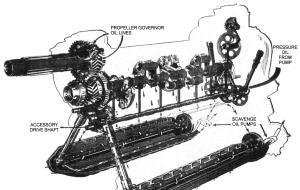 |
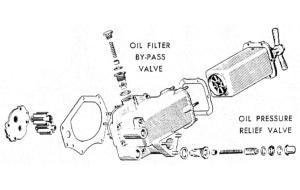 |
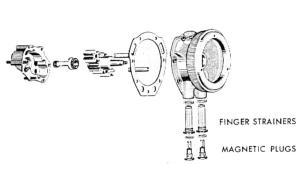 |
| Lubrication System | Oil Pressure Pump | Oil Scavenge Pump |
A Holley 700H updraft pressure carburetor provides the induction mixture. The carburetor main fuel valve is operated by two diaphragms that form a chamber between them. The inside of the chamber is filled with fuel under pressure, while the outsides of the chamber are connected via a passage to the carburetor venturi section. At low engine speed, when little fuel is required, the diaphragms are drawn apart by venturi suction and the valve that admits fuel is nearly closed. At high engine speed the venturi provides little suction and the diaphragms move together, admitting more fuel. Since the chamber is always completely filled with fuel, the carburetor is unaffected by gravity and will function in any position or acceleration. The carburetor employs a variable-opening venturi to control airflow. Two throttles of cylindrical shape are located on opposite sides of a rectangular duct and geared together. As the opening between them is varied an almost perfect venturi shape is preserved at all times, making the carburetor almost completely free of icing trouble. Other features compensate for altitude. Adjustment screws control idling speed and mixture.
The centrifugal supercharger is driven at 9.5 times crankshaft speed from the crankshaft front via a long, flexible drive shaft, which eliminates the need for a sliding clutch to isolate crankshaft torsional vibration from the supercharger inertia. The supercharger forces the air/fuel mixture from the carburetor into two intake pipes at either side of the supercharger housing. Each cylinder bank has its own intake pipe system, specially tuned to evenly distribute the mixture. This includes the supercharger elbows, main intake pipes, a special Y fitting and two short elbows that connect with two cast magnesium manifolds, each supplying three cylinders.
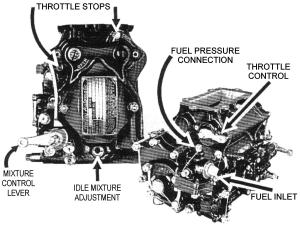 |
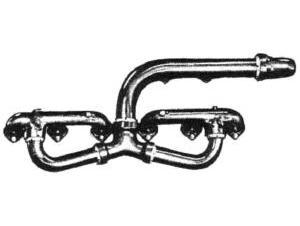 |
| Holley 700H Carburetor Right and 3/4 Left Aft Views |
Intake Pipes and Manifold |
The magneto is a single Bendix-Scintilla DF-126 dual magneto mounted on the rear section top, left of the starter drive housing. Since the propeller provides a smooth and uniform rate of rotation at the crankshaft front, the magneto is driven from this point via the accessory drive shaft and vertical magneto drive shaft. The magneto is splined to its drive shaft that drives it at 1.5 times crankshaft speed and attached by two studs extending through slots in its flange, which allow timing adjustment. The dual magneto has a single four-pole magnet rotating between two coils, each of which has its own contact breaker and condenser operated by a single breaker cam. This arrangement provides dual ignition with the light weight and simplicity of a single magneto. A high tension lead runs from each coil to a separate 12-cylinder distributor.
The distributors are located at the cam housing's aft ends immediately behind the scavenge pumps and are driven directly by the camshafts. The right-hand distributor provides high-tension current to the intake spark plugs, while the left-hand distributor supplies the exhaust plugs, all through radio-shielded leads.
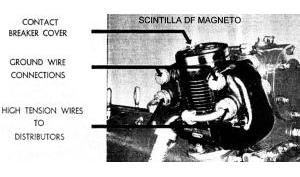 |
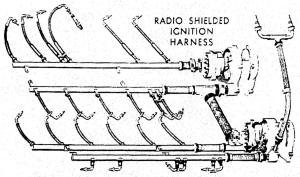 |
| Magneto | Ignition Harness |
Accessory drives are provided for starter, generator, vacuum pump, fuel pump, hydraulic pump, gun synchronizer, electric tachometer, mechanical tachometer and propeller governor. All but the propeller governor are mounted on the rear section.
| Accessory | Rotation (Facing Pad) | Gear Ratio (Drive:Crankshaft) |
|---|---|---|
| Magneto | CW | 1.5:1 |
| Starter | CCW | 1.0:1 |
| Generator | CW | 1.0:1 |
| Tachometer, Mechanical | CW | 0.5:1 |
| Tachometer, Electric | CW | 0.5:1 |
| Fuel Pump | CW | 0.72:1 |
| Vacuum Pump, Upper | CCW | 1.227:1 |
| Vacuum Pump, Rear | CCW | 1.2:1 |
| Gun Synchronizer | CW | 0.666:1 |
| Propeller Governor | CCW | 1.5:1 |
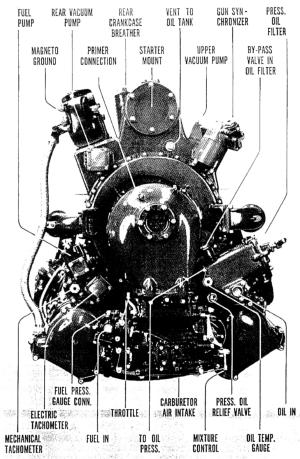 |
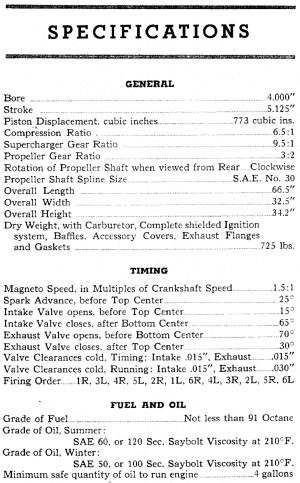 |
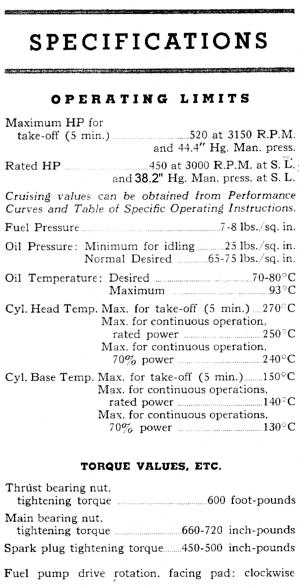 |
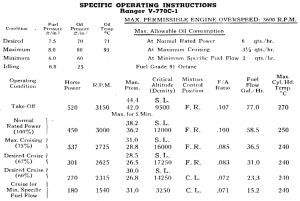 |
| Accessory Section | Specifications | Specifications | Specific Operating Instructions |
- More Ranger SVG-770 Details in the Members' Section -